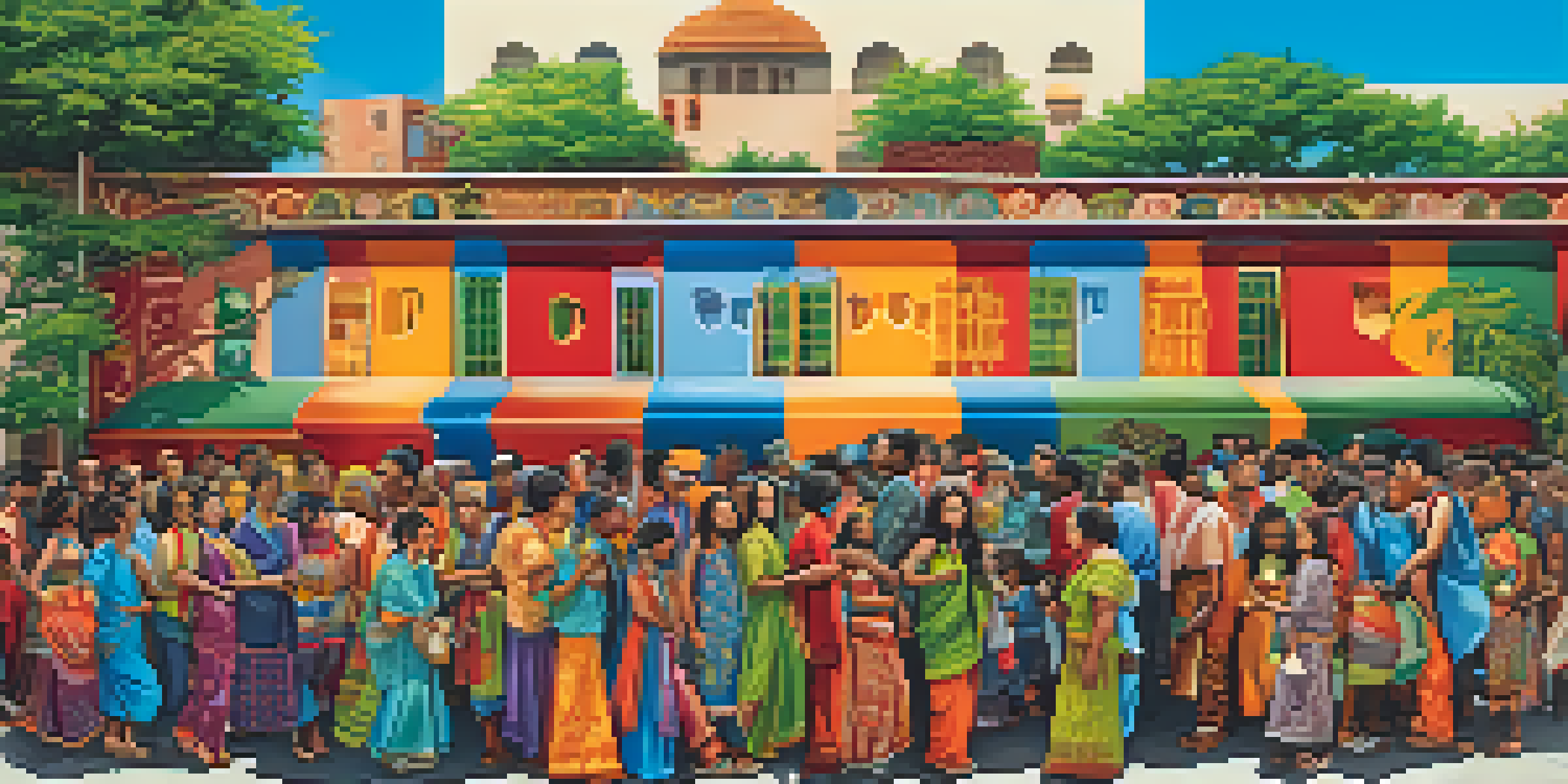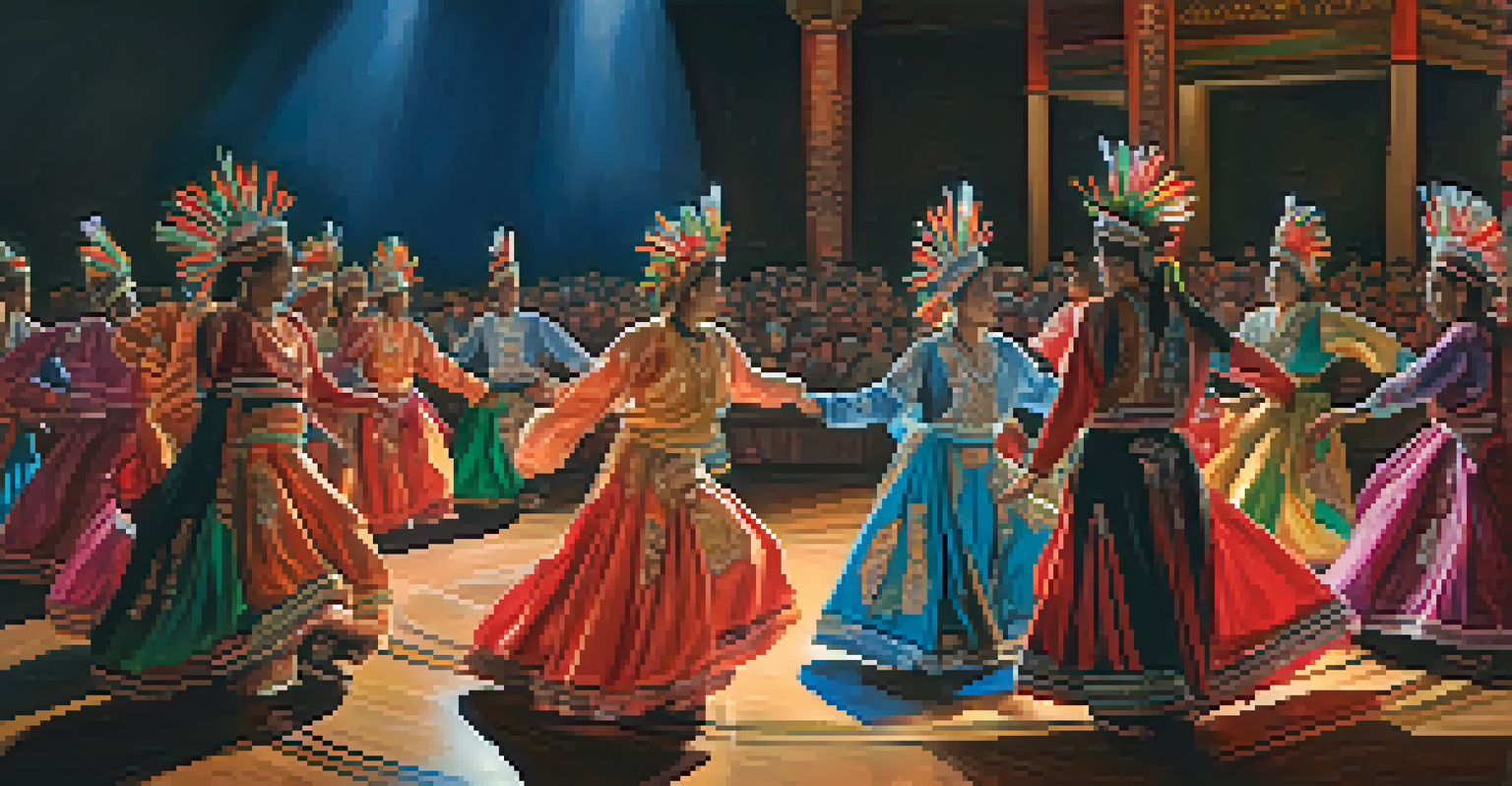Cultural Narratives: Art's Exploration of Human Diversity

Understanding Cultural Narratives Through Art
Cultural narratives are stories that encapsulate the beliefs, values, and experiences of a community. Art serves as a powerful medium to communicate these narratives, allowing for a deeper understanding of diverse cultures. From paintings to sculptures and performances, each art form provides a unique lens through which we can appreciate human diversity.
Art is the most beautiful of all lies; it is the most beautiful of all truths.
For instance, Indigenous artwork often tells stories of creation, spirituality, and the relationship between nature and humanity. These narratives are not just historical; they continue to evolve, reflecting contemporary issues faced by the community. By engaging with such artworks, we can gain insight into the complexities and richness of different cultural backgrounds.
Ultimately, art invites us to step into someone else's shoes, broadening our perspective and fostering empathy. This exploration can challenge stereotypes and promote a more inclusive view of humanity, encouraging us to celebrate rather than fear our differences.
The Role of Visual Art in Cultural Storytelling
Visual art plays a crucial role in storytelling by using imagery to convey messages that words often cannot. Artists from diverse backgrounds harness colors, shapes, and textures to express their cultural heritage and personal experiences. This visual language can transcend barriers, allowing people from different backgrounds to connect over shared themes of human experience.

Take, for example, the vibrant murals found in urban areas, which often depict the struggles and triumphs of marginalized communities. These artworks not only beautify spaces but also serve as a form of public storytelling, giving voice to those often unheard. By showcasing their narratives through visual means, artists empower their communities and invite dialogue.
Art Communicates Cultural Narratives
Art serves as a powerful medium to express and understand the beliefs, values, and experiences of diverse communities.
Moreover, the engagement with visual art can spark curiosity and inspire further exploration into the cultures being represented. Viewers are encouraged to ask questions, seek understanding, and appreciate the diverse stories that shape our world.
Performative Arts: A Dynamic Cultural Expression
Performative arts, including dance, theater, and music, are vital for conveying cultural narratives. These art forms offer a dynamic way to embody stories, emotions, and traditions, often involving the audience in the experience. Such interactions create a shared space where cultural expressions can thrive and be celebrated.
The artist is not a different kind of person, but every person is a different kind of artist.
Consider traditional dances that communicate the history and customs of a culture. Through movement, performers can express the joys, struggles, and hopes of their communities, inviting viewers to feel the pulse of their heritage. This immersive experience strengthens cultural ties and fosters appreciation among diverse audiences.
Performative arts also adapt to contemporary issues, allowing artists to address current social and political contexts. By weaving in modern themes, these art forms remain relevant and resonate with audiences, ensuring that cultural narratives continue to evolve and inspire.
Literary Arts: Weaving Narratives of Diversity
Literary arts, including poetry, novels, and essays, serve as powerful vessels for cultural narratives. Through storytelling, writers can explore the intricacies of their identities and the communities they represent. This written expression allows for reflection on personal and collective experiences, bringing diverse voices to the forefront.
For instance, contemporary novels often tackle themes of migration, identity, and belonging, reflecting the globalized world we live in. By sharing these narratives, writers not only educate readers about different cultures but also encourage a deeper understanding of shared human experiences. Each story adds a unique thread to the rich tapestry of human diversity.
Digital Media Expands Cultural Voices
The rise of digital platforms allows underrepresented artists to share their cultural narratives with a global audience.
Moreover, literature can inspire change by challenging readers' perceptions and prompting critical thought. Engaging with diverse literary works fosters empathy and connection, illuminating the commonalities that bind us together while celebrating our differences.
Music as a Universal Language of Culture
Music is often described as a universal language, transcending cultural barriers and connecting people across the globe. It serves as a powerful form of expression that conveys emotions, traditions, and stories, allowing listeners to experience the heartbeat of various cultures. Through rhythm, melody, and lyrics, music communicates the essence of cultural narratives.
Consider how folk music reflects the history and struggles of a community. Each note embodies the stories passed down through generations, creating a sense of identity and belonging. When we listen to these songs, we not only enjoy the art form but also engage with the rich history and culture behind them.
Moreover, music festivals and collaborations between artists from different backgrounds promote cultural exchange and understanding. These events celebrate diversity while fostering connections, proving that music can unite us in our shared humanity.
The Impact of Digital Media on Cultural Narratives
With the rise of digital media, cultural narratives have found new platforms for expression and dissemination. Social media, blogs, and online art galleries allow artists from diverse backgrounds to showcase their work, reaching wider audiences than ever before. This democratization of art enables underrepresented voices to share their stories and experiences.
For example, platforms like Instagram have become vital for visual artists and performers to share their narratives instantly. This immediacy not only captivates viewers but also encourages dialogue around the cultural themes presented. The ability to connect globally fosters a greater appreciation for human diversity and can spark movements for change.
Art Promotes Empathy and Change
Engaging with diverse artistic expressions fosters empathy and can inspire social change by challenging stereotypes and encouraging dialogue.
However, digital media also presents challenges, such as the risk of cultural appropriation and misrepresentation. It is crucial for creators and audiences alike to approach cultural narratives with respect and understanding, ensuring that diverse voices are heard authentically.
Art as a Catalyst for Cultural Understanding and Change
Art has the remarkable ability to act as a catalyst for cultural understanding and social change. By presenting cultural narratives, artists can challenge stereotypes, provoke thought, and inspire action. Art encourages us to confront uncomfortable truths and consider perspectives we may not have encountered otherwise.
For instance, powerful exhibitions addressing social justice themes can mobilize communities and spark conversations about pressing issues. These artistic expressions not only highlight injustices but also celebrate resilience, fostering hope and empowerment within affected communities.

As we engage with diverse artistic expressions, we become more aware of the complexities of our world. This awareness is the first step toward fostering a more inclusive society, where cultural narratives are celebrated and valued, ultimately enriching our shared human experience.